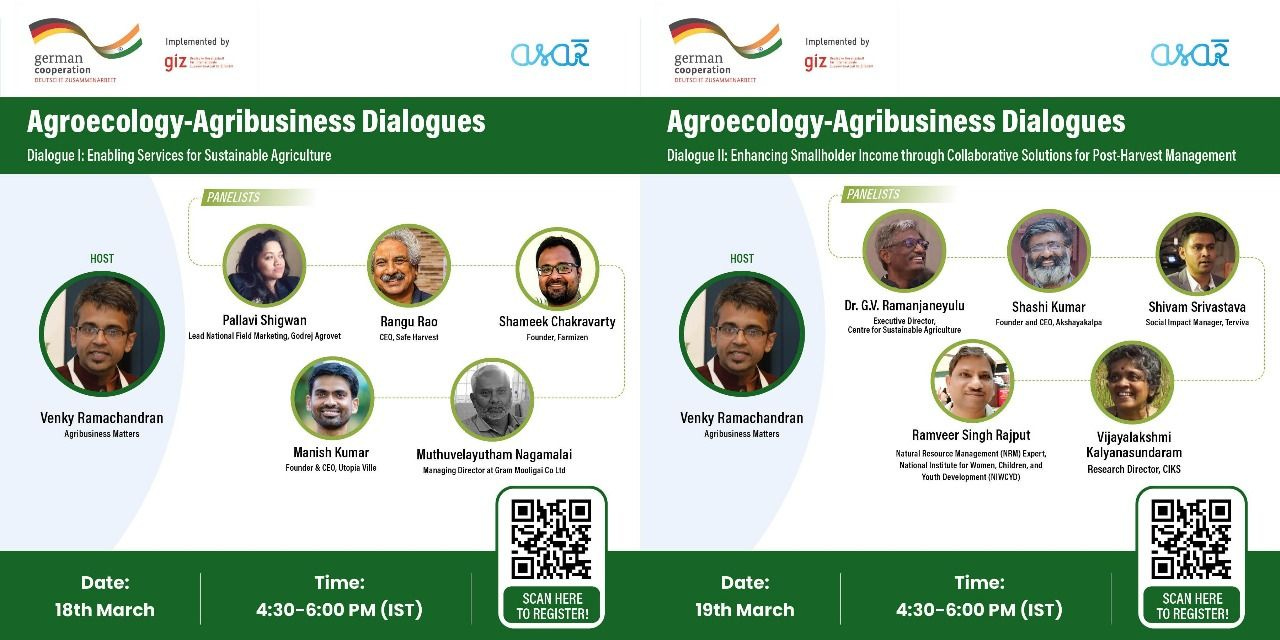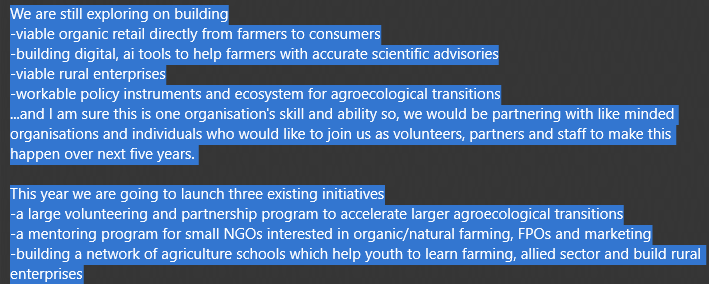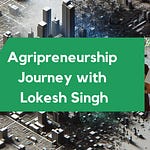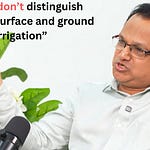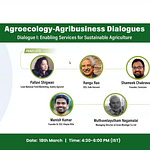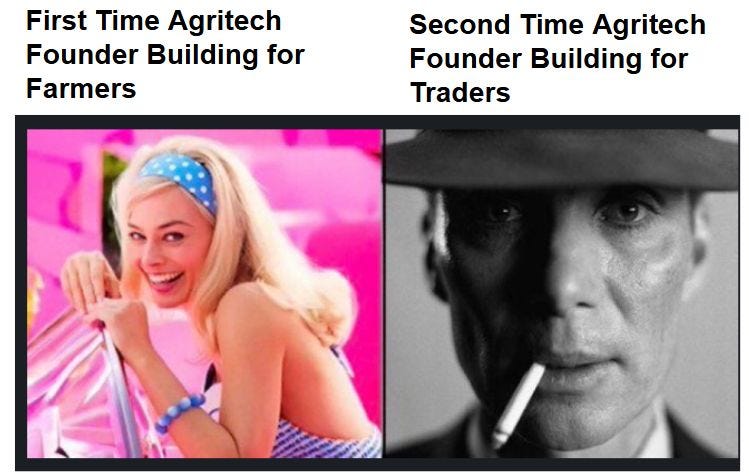
Agroecology Agribusiness Dialogues
In the first part of Agroecology-Agribusiness Dialogues, we talked about what it takes to bridge Agroecology with Agribusiness. The central metaphor I explored in documenting the learnings involved two Systems - System B and System M.
Agribusinesses today have built their scale-driven broad-gauge production and post-harvest systems (System B) across the country that are unsuitable for scale-invariant meter-gauge (System M) production and post-harvest systems meant for Agroecology.
For all the promise agroecology and regenerative agriculture hold, it hasn’t yet built sufficient alternative market structures and hence ends up beaten up black and blue inside the market structures that have been built for the industrial agriculture paradigm.
In Part-2, we explored the messy pathways walked by those brave souls who are building those bridges.
Vijayalakshmi Kalyanasundaram shared about the authenticity crisis she is grappling with in System M while conserving 171 rice varieties and making them market-friendly. When every red rice is sold as Mappilai Samba or Kattu Yaanam, spurred by volatile social media diet fad trends that often lead to crash of prices, the consumers are left in the lurch without any reasonable means to authenticate the rice varieties at display and figure out the best rice varieties best suited for their bodies.
She talked of the challenging journey in transitioning from a non-profit to for-profit while supporting 23 farmer producer companies, besides wholesale and retail marketing, gifting rice packets to pique curiosity and teaching consumers the art of cooking several forgotten traditional rice varieties. Her agroecological transition approach, in short, spans from seed to market to table.
The market response has been encouraging. In Chennai alone, 15 to 20 traditional varieties are now regularly available on organic shop shelves. Yet challenges persist, particularly around consumer psychology. Why have we programmed Indian customers to step out of a Mercedes-Benz and balk at paying ₹150 INR per kg for rice, while spending ₹5,000-10,000 INR without a wink at restaurants?
Ramanjaneyulu GV has spent two decades in supporting the organic transition of more than 30,000 farmers, with FPOs reaching 32 crore INR turnover (~ 4 Mn USD) and CSA PGS regional council becoming largest PGS organic certifier with over 300000 acres in several Indian states.
I asked Ramoo how he sees the next twenty years in building the bridge between System M and System B. He shared an uncomfortable prognostication that left me revisit the complexity involved in strengthening farmer livelihoods: Even if the agroecological transition were to happen (with natural farming growing from 2 % to 20% over the next ten years), we wouldn’t have addressed the crux of farmer livelihoods. Farmer incomes would still be a challenge.
While farmers are expected to make complete transitions from conventional to organic farming, public policies continue supporting conventional agriculture through massive subsidies.
When policy systems support System B, when business models are designed around System B, when cropping incomes only contribute to 30% of farmers’ incomes, we are dealing with a wicked problem of facilitating agroecological transition.
Ramoo also shared a scathing critique of India's extension system: lack of accountability for outcomes. When extension workers' salaries and promotions aren't linked to farmer well-being, the system becomes "a bureaucratic system to deliver subsidies or to mobilize farmers for politicians' meetings".
India's public extension system reaches only 6% of the country's 119 million farmers, despite its extensive network. When success stories do emerge, they typically come through women's self-help groups or FPOs where staff are employed, valued, and paid by the communities they serve.
I asked Shashi Kumar what would accelerate agroecological transition amidst investors who question the ROI of the farmer infrastructure support work undertaken by Akshayakalpa.
While acknowledging Brahma Nirasana (ಭ್ರಮನಿರಸನ) - disillusionment - in moving the needle for the betterment of farmers, he addressed the two ends - value creation and value realisation. He talked about Akshayakalpa’s model in enabling farm-level diversification (producing milk, eggs, vegetables, coconut and honey) that helps farmers with multiple revenue streams from the same land.
Akshayakalpa farmers average ₹1 lakh per month in income, with 30-40% having reverse migrated from cities back to farming. This isn't just about premium pricing—it's about operational efficiency achieved through diversification. As Shashi notes, "the gross margin profile can only be created if there is a stability in the supply". How do we build stability in pricing systems is the key question.
Soil organic carbon levels on Akshayakalpa farms have increased from an average of 0.32% to 2.44% over a 10-year period. Shashi also shared glimmers of hope in how the investors are understanding the need to give back further to the society. He acknowledged the limited success so far and warned against repeating mistakes of agricultural consolidation in the West, urging a focus on small farms and sustainable models.
Ramveer Singh Rajput shared the importance of bridging production with consumption while working on agroecological transition. Ramveerji’s work in tribal areas of Madhya Pradesh highlights both the potential and limitations of current FPO models. He shared fascinating insights on caste labour dynamics, reviving barter systems through the grain-for-rice exchange schemes and bio-input resource centers that could contribute towards building System M infrastructure.
Shivam Srivastava talked about Terviva’s efforts to revive Pongamia Pinnata as a multipurpose crop, focusing on community investment, women’s entrepreneurship, and value addition to maximize its potential.
Terviva avoids monoculture by limiting Pongamia to 10% of plantations and promoting agroforestry systems with diverse intercropping. They have created nine different product streams from pongamia, from biodiesel to fertilizer to food ingredients.
Is there a risk to food security when we do agroecological transition?
The greatest risk perhaps lies not in transitioning towards agroecological systems, but in failing to do so. Depleting soil health, water scarcity, and farmer indebtedness pose far greater threats to the future of Agriculture than the challenges of transition. Can we reframe the familiar debate - hoary cliches of fears of food security - to focus on food safety, resource sustainability, and farmer livelihoods?
Our ideas of transition are far strongly cultured by sudden shifts, rather than gradual shifts. Can we work with a twenty year horizon, do continuous experiments, cross-pollinate ideas with the ecosystem and build resilient rural economies?
So, what do you think?
How happy are you with today’s edition? I would love to get your candid feedback. Your feedback will be anonymous. Two questions. 1 Minute. Thanks.🙏
💗 If you like “Agribusiness Matters”, please click on Like at the bottom and share it with your friend.



